Last August, the game Flippy Knife from the Russian team Beresnev topped the world charts. The studio’s debut project, which previously specialized in graphics and animation, was downloaded 20 million times, and its revenue amounted to a six-figure sum. We publish a story by the founder of the studio Oleg Beresnev about where the team started and how it achieved success.
The report was read at White Nights Moscow 2017. We have prepared a printed version of the speech.

Oleg Beresnev
Flippy Knife is our first game. We launched it on August 4. In 2 months, she has achieved 20 million downloads and managed to visit the top of the App Store and Google Play in all major countries and in many minor ones.
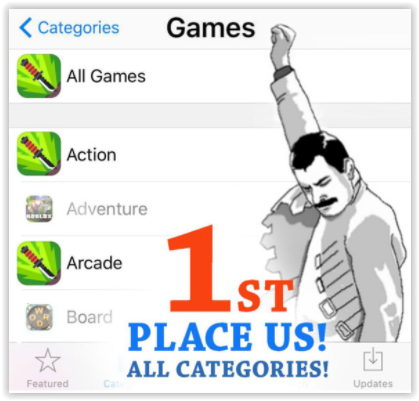
This is what the App Store of many countries looked like in the first weeks of release
The topic of my story is how to make a successful game the first time. More precisely, taking what steps, I came to this with the team.
Step #1. To do only what the heart asks
So, what do you need to do to make the game successful the first time?
You have to put aside any doubts and needs, you have to give yourself completely to the cause. You should take up the project with love, pay no attention to anything else and believe that everything will work out.

How long can it take?
I fit in at four. And it was psychologically difficult. 2 years of psychotherapy and my girlfriend helped me overcome this time.
I was alone, I had no money, I was sitting in Krasnoyarsk, I didn’t go anywhere. I had never worked anywhere before, I had no completed education. However, as it is not now.
But I loved to draw. And I started making art for stock image sites (those sites where one picture can be bought many times — approx. editorial offices).
At that time, I didn’t think I could assemble a team and do art seriously.
Step #2. Enjoy the things you do
It so happened that I taught my girlfriend to draw and we started working together. At first there were no orders, but one day I drew her a gift for March 8 (it’s on the slide just below).
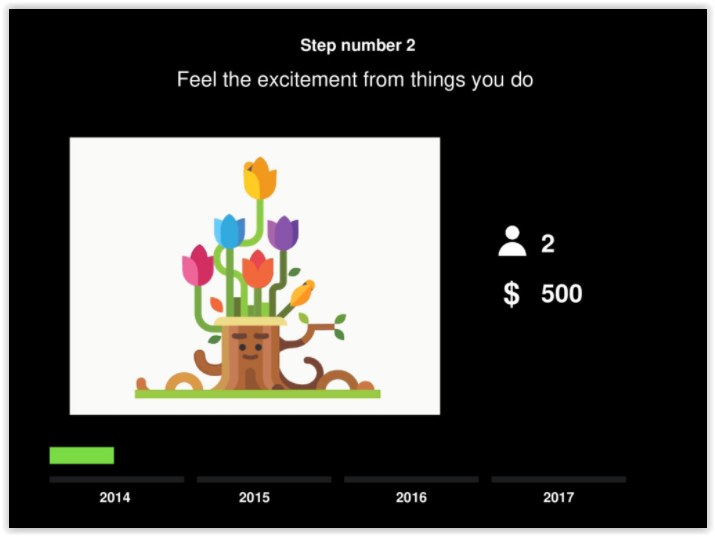
After that, orders fell down. There was no talk of business or games back then. We have come to this gradually.
We drew graphics together, received more and more orders, and so there was excitement. I wanted more, I wanted development. But the most important thing: I realized then that taking any action, changing the world around me, is just as strong a feeling as the love of my work.
Step #3. Be cool in the chart
We rented a small apartment and by the end of 2014 there were already four of us. None of the new guys had much experience in the field of art.
We could not understand and not understand this or that style of graphics. But that never stopped us. We sat down and began to master it on our own. That’s how we became specialists.
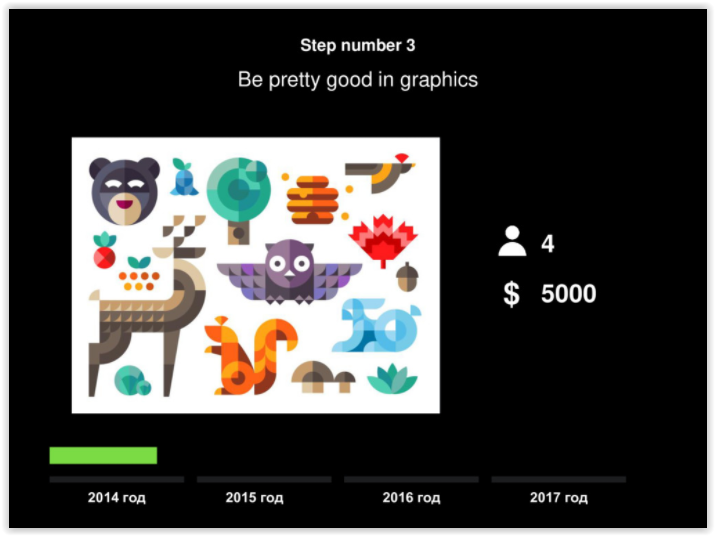
We studied and more and more orders came.
Step #4. Make videos and animations
By the end of 2014, there were already six of us. The approximate monthly earnings of the studio was $ 5 thousand. And we wanted to keep developing. They began to think where. So we took up video and animation, which we had never done before. We mastered everything ourselves again from scratch.

And we have achieved success. On Dribbble and Behance, any of our work collected a frenzied number of likes.
Then it was possible to stop. Keep making videos and live well. But it just so happens that every six months we abandon the old and grow further.
Step #5-7. Work with Facebook
We have taken up close work with Facebook. We did product design for them. It was thanks to this experience that we realized how the mentality of such corporations differs from small companies.
We learned how to work with them, figured out how they are arranged inside, how to interact with them. And, of course, we grew up and began to earn even more.
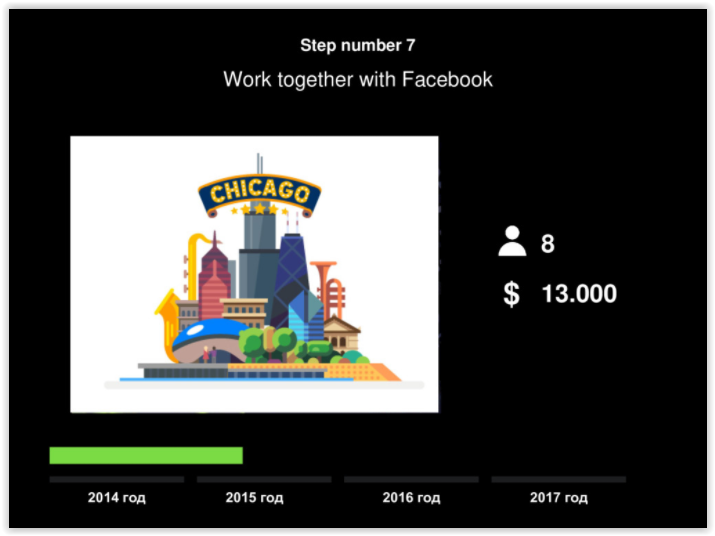
Step #8. Learn to inspire people
Then we wanted to learn how to inspire other people. At that moment, we were no longer interested in earnings. We wanted to create only something that would “hook” people, that would cause them emotion and some kind of reaction.

We spent six months creating animations that encourage something. Including encouraging us to do more ourselves. So there were thoughts that we should move towards games. This is the natural way: from graphics to animation, and from animation to games.
Step #9. Become one family with the team
We have never had an official relationship inside. We have always been a friendly, close-knit team. We are all friends, we experience all positive emotions together.

We try as a team to be one. This is necessary in order for such complex processes as creating games to go without problems.
Step #10. Entrust all your ideas to the programmer for implementation
We set about creating the game. We prepared graphics, animation, ideas, and then just took it and entrusted it all to the programmer.
And got into the minus by $ 2 thousand.
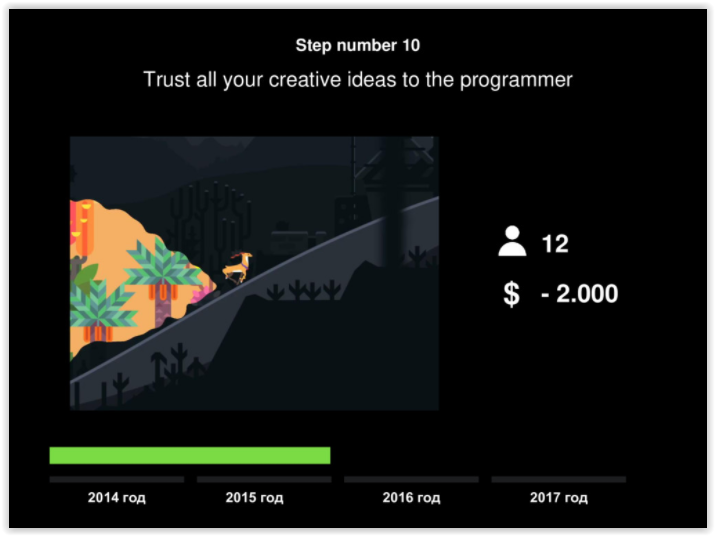
There was no catastrophe in this. The most important thing is that we liked the process, we liked making the game. We didn’t care about anything else. We just felt we were on the right track.
The biggest problem for us was that with our perfectionist views, taking on such a difficult task as creating a game, we could not stop. We dug deeper and deeper, we wanted to make everything better. And we got so deep into it that at some point we lost the general vision of what we want to do.
It was time to slow down and figure out how to do it right.
Step #11: Gain experience in game design by working to order
If you are going to make a game yourself, you should, even at a loss to yourself, try to participate in the development of games for other companies.
It’s not about sharing experiences, it’s not about gaining knowledge about processes. The most important thing is that you can learn a lot from the mistakes of others.

In 2016, there were already fourteen of us and we earned $10 thousand a month on custom games.
Step #12. Learn in 3D
Having taken up the development of custom games, we realized that we needed to understand three-dimensional graphics. We decided to study 3D independently within the team, to learn all the subtleties of the work.
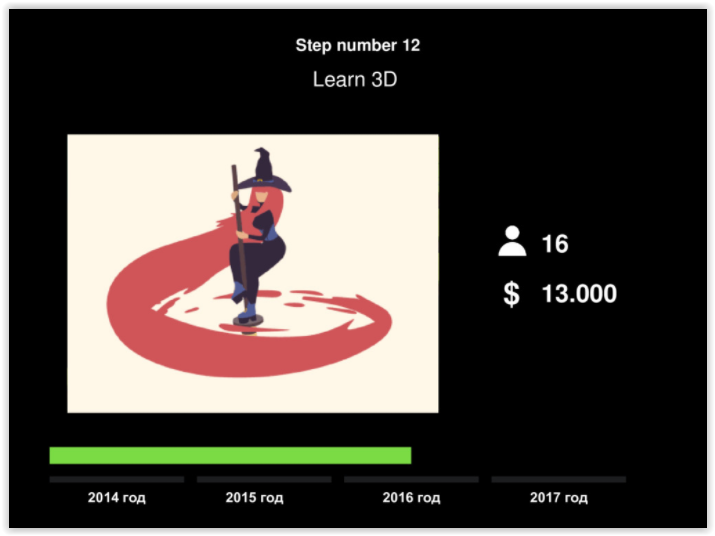
We did not want to resort to outsourcing. It is impossible to control all emotions during remote development. You can control the timing, the volume, but the emotions that a person experiences when creating something cannot be understood.
So we have a 3D department.
Step #13. Make a sound design inside the studio
Initially, we decided to outsource the creation of music after all. The fact is that I have never played any instrument myself. At that time, we did not dare to master this area on our own.
Of course, there were doubts. And, as experience has shown, not unfounded. No miracle happened. I had to study everything from scratch again.
Now we have a person inside the studio who is solely responsible for music and sound design.
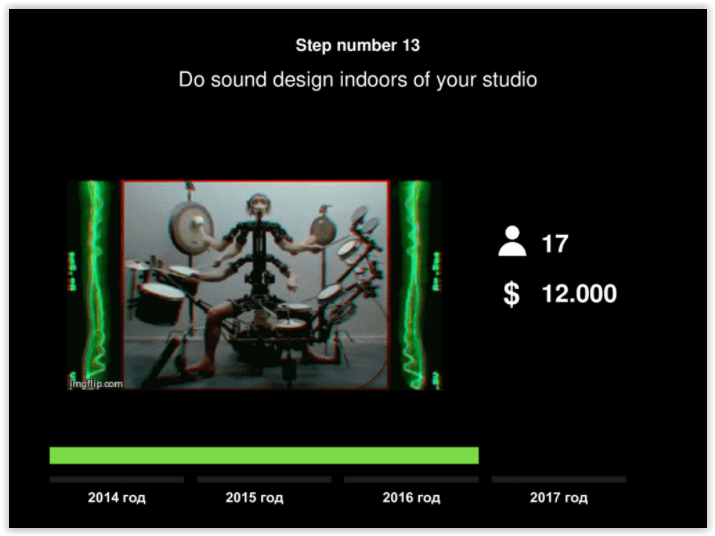
We met the end of 2016 with a composition of seventeen people. Everyone is tuned to the same wave, everyone has priority:
- do only what you like;
- believe in success;
- treat your business with love.
I think that’s what allowed us to make a hit. This is the secret of our success.
How did the idea of Flippy Knife come about?
The first game we started was a project about an antelope. A large-scale, big, ambitious game that we have been working on for a year.
We brought it almost to completion, and then went to the White Nights conference in Prague. The goal was to get feedback.
All the publishers we talked to wanted to get her in their portfolio. But they wanted to get cheaper. People, let’s say, with whom everyone wants to get acquainted at such conferences, gave the project high marks. However, numerous conversations with experts led to the fact that we realized: the whole game needs to be redone.
At that time, it would have been a very difficult decision for us to undertake a total redesign of the project. We’ve been making the game for a year. We worked “to zero”: part of the team earned something, the rest only spent, trying to create something new, go somewhere further, to a new level.
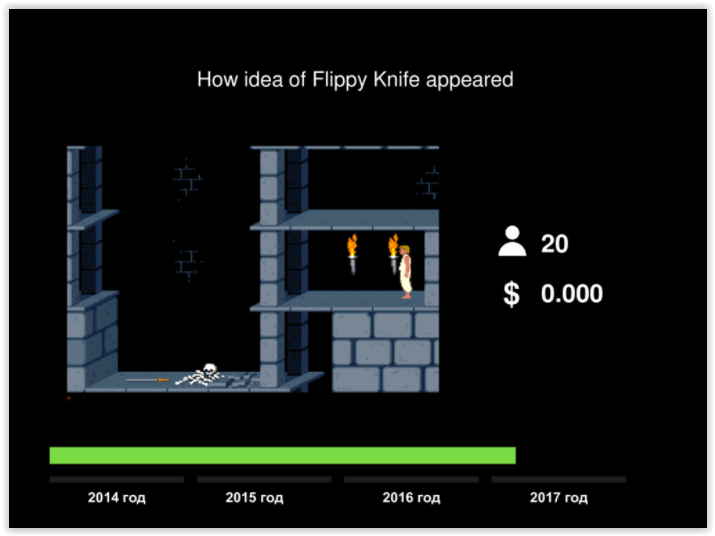
I understood that I needed to change something, to distract myself. And at the end of February 2017, we decided to make some small game in a month.
We wanted to understand how to put games on the App Store, on Google Play, how to make a list of tags, and in general to find out what marketing is, whether it is possible to do without it. And that’s how the idea of Flippy Knife was born.
The concept of the game about throwing knives appeared in the evening from the idea of the runner, which was a game about an antelope, and the concept of our other project, which we made to order. In that project, the player had to carefully and accurately turn over the pieces of meat.
I didn’t want to delay the development. And the situation was psychologically difficult.
Development of Flippy Knife
In the first week of work, prototypes began to appear. And then we realized that we would not fit into the month. The project itself hooked us. I wanted to make the game not only as an experiment, but as a full-fledged work, in which a lot of love is invested.

In the third month of development, she and I came to Game Access in the city of Brno, Czech Republic. There were a lot of developers at the conference who gave a lot of practical advice.
It turned out that this show was a test for the game. We have received a lot of feedback. And everything dragged on again.
Monetization
While working on the project, we began to understand which ideas for monetization can be used in the game, which will not be repelled. For us, as designers, the opinion of users is very important.
For example, we have a game mode in which a knife has to jump from platform to platform. One of the platforms is a TV. 30 coins are given for jumping on it. Plus, the ad playback starts automatically. The player can send the knife past the TV to another platform, but it is easier to send it to the TV box.
We have not received any negative feedback from users on this advertisement. We searched carefully, but there are no such reviews. This advertisement does not affect the gameplay in any way and fits perfectly into the gameplay.
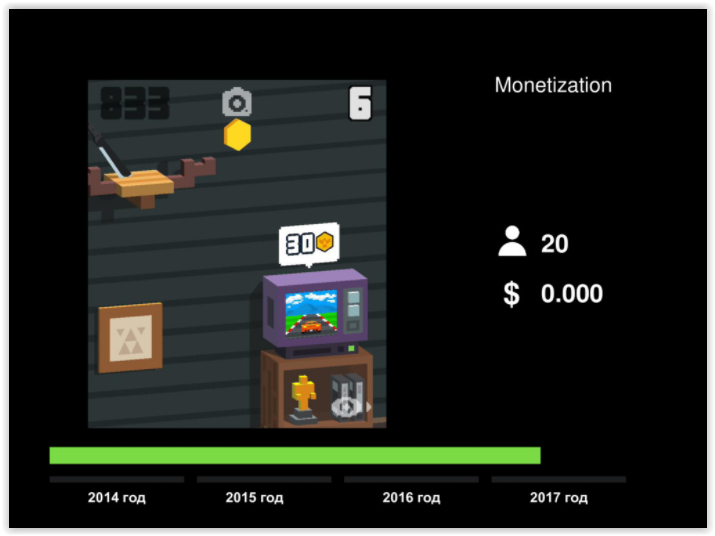
We have a bunch of knives in the game that people open by watching ads. They bring the bulk of the profit, and the TV brings exactly half of the whole of this main part.
Marketing strategy
We didn’t have the money to promote. We couldn’t afford to spend anything. And they didn’t spend it. Unwound without them.
We can draw, animate, do something. And we offered YouTubers a barter: they talk about us on their channel, and we make any content in the game at their request.
There were several powerful influencers with a guaranteed million views who agreed to help us.
It turned out to be beneficial not only to us, but also to them. One of the streamers wrote a few weeks after the video was published that we brought him a lot of money. The fact is that an article about his video appeared in the press, it attracted a lot of clients to him, who were then placed with him on commercial terms.
After the release
We didn’t sleep for a week after the release. Hardly slept. We had the following schedule: someone sleeps for two hours, then wakes up, someone else sleeps for two hours instead, then wakes up again and works. And so around the clock. The excitement was frenzied!
We earned well on the game.
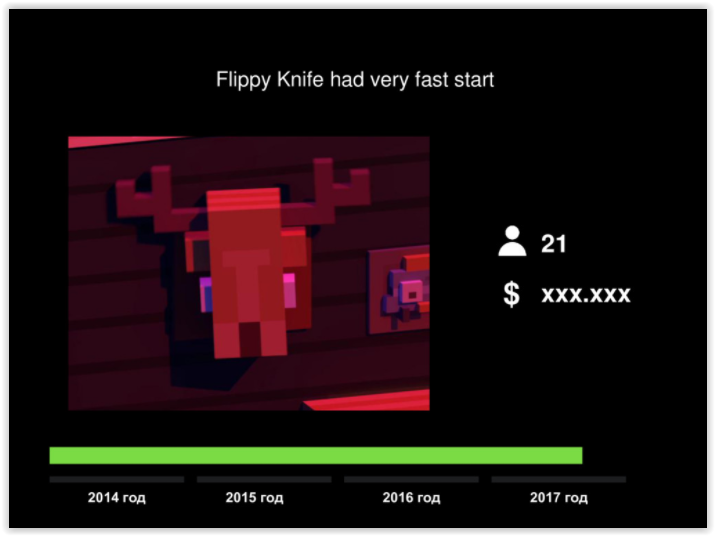
And we have achieved a great result in social networks.

It was fun.
The video from the report can be viewed here.
